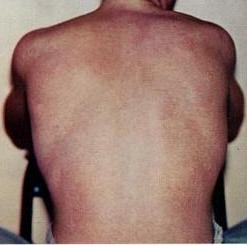Dengue fever physical examination: Difference between revisions
(→Skin) |
|||
| Line 40: | Line 40: | ||
==References== | ==References== | ||
Revision as of 19:26, 14 June 2014
|
Dengue Fever Microchapters |
|
Diagnosis |
|---|
|
Treatment |
|
Case Studies |
|
Dengue fever physical examination On the Web |
|
American Roentgen Ray Society Images of Dengue fever physical examination |
|
Risk calculators and risk factors for Dengue fever physical examination |
Editor-In-Chief: C. Michael Gibson, M.S., M.D. [1]
Overview
The classic picture of Dengue Fever includes a high fever with no localizing source of infection on physical examination, with petechia being present occasionally. The physical examination in Dengue fever should be directed to ward identifying signs that the patient has severe disease warranting admission or in-hospital observation.
Vital Signs
Tachycardia, postural hypotension, and hypotension could indicate dehydration. Patients who are triaged to home management should urinate at least every 6 hours.
The tourniquet test
Skin
If the patient has poor perfusion, the skin may be cold and clammy.
Petechiae may be present.
-
The above picture is a rash typically associated with Dengue fever.
Mental Status
Lethargy and restlessness are warning signs that the patient should be monitored.
HEENT
Mucosal bleeding is a warning signs that the patient should be monitored.
Lungs
- Pleural effusion is a warning sign the capillary leak may be occurring and that the patient should be monitored.
Abdomen
- Abdominal pain or tenderness are warning signs that the patient should be monitored.
- Liver enlargment >2 cm is a warning signs that the patient should be monitored.
- Ascites is a warning signs that the patient should be monitored.
Extremities
- Pedal edema or evidence of fluid accumulation
